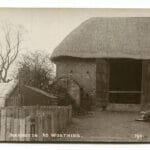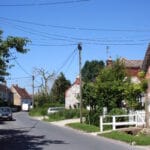Durrington, Wiltshire, is more than just a charming English village nestled near the iconic Stonehenge. It’s a living testament to millennia of human history, a captivating blend of ancient mysteries and modern life. From its Neolithic beginnings as a bustling settlement to its present-day existence as a thriving community, Durrington offers a unique window into the past and a glimpse into the future.
Durrington’s Neolithic Heart: A Giant Among Settlements
Around 4,500 years ago, Durrington wasn’t the quiet village we know today. Archaeological evidence suggests a thriving Neolithic settlement, significantly larger than initially believed, surrounded by the massive earthwork enclosure known as Durrington Walls. Imagine a sprawling community, possibly exceeding the population estimates of many settlements of that period, bustling with activity. The sheer scale of Durrington Walls, dwarfing even Stonehenge in its area, points to a sophisticated society, well-organized and capable of undertaking monumental construction projects.
Adding to the enigma is nearby Woodhenge, a circular arrangement of postholes whose purpose remains debated. Some experts believe it served as a ceremonial site, possibly linked to Stonehenge’s function; others suggest it may have had a different, perhaps complementary, ritualistic role. The interconnectedness of these sites—Durrington Walls, Woodhenge, and Stonehenge—suggests a complex and possibly interconnected network of activity during the Neolithic period. Ongoing research continues to reveal new information, gradually clarifying the relationships between these sites and promising further refinements to our understanding.
A Tapestry of Time: From Neolithic to Modern Durrington
Durrington’s story stretches far beyond the Neolithic period. While the evidence of Roman occupation is scant, suggesting perhaps a shift in regional importance, the village’s history continued, albeit with fluctuating populations, through the Bronze Age and the Medieval period. The Domesday Book entry from 1086 likely provides a momentary glimpse into the structure of medieval life in the village, an aspect which warrants further study.
The 20th century brought significant change with the establishment of Larkhill military base nearby. This resulted in a remarkable transformation of Durrington, altering its demographic profile and infrastructure, and significantly impacting its cultural fabric. The village transitioned from a primarily agricultural community to a diverse settlement, blending its ancient heritage with the realities of modern life.
| Period | Key Events and Characteristics | Significance |
|---|---|---|
| Neolithic (c. 3000-2000 BC) | Construction of Durrington Walls and Woodhenge; thriving settlement, possibly connected to Stonehenge construction. | Demonstrates a sophisticated, well-organized society with significant organizational capabilities. |
| Bronze Age | Continued occupation, though possibly with a smaller population. | Suggests continual, albeit potentially reduced, habitation of the area. |
| Roman Period | Limited evidence of Roman presence. | Indicates Durrington may not have been a major center of Roman activity. |
| Medieval Period | Development as a small agricultural village within the manorial system; evidence in the Domesday Book (1086). | Provides a glimpse into agricultural practices and societal structures of the time. |
| Modern Era | Establishment of Larkhill military base; significant population growth; development of modern amenities. | Transformed Durrington from primarily an agricultural village into a more diverse community. |
Modern Durrington: Ancient Echoes in Everyday Life
Today, Durrington is a thriving village where the echoes of its ancient past resonate within a vibrant modern community. The relaxed atmosphere, welcoming pubs, and local shops create a unique charm. The proximity to Stonehenge, naturally, plays a significant role in the village’s economy, attracting visitors and shaping its identity as a center for tourism. The challenge for Durrington’s future likely involves balancing the preservation of its remarkable heritage with the demands of sustainable development and responsible tourism. Preserving the Neolithic legacy while adapting to the needs of a modern community is a delicate balancing act.
The Durrington-Stonehenge connection, a central mystery, continues to fascinate and inspire researchers. Were they linked by specific seasonal rituals? Were the inhabitants of Durrington involved in the construction or use of Stonehenge? The answers remain elusive, highlighting the ongoing need for careful archaeological investigation and historical analysis.
Durrington’s Population: Then and Now
Determining the precise population of Durrington presents a challenge. While historical records, like the 1676 record, offer glimpses into the past, contemporary data is often aggregated within wider administrative areas, making it difficult to isolate Durrington’s precise numbers. Estimating the modern population requires careful analysis of data from various sources, acknowledging the inherent uncertainties involved. The 2011 Census might provide some general insights but would likely underrepresent the current population. Even with such caveats, it’s possible to provide a reasonable range based on extrapolated data from the larger Wiltshire region and acknowledging the significant limitations in the data. Future research could shed more light on the modern demographic structure of Durrington.
Is Durrington a Town or a Village?
Defining Durrington as either a town or a village is ultimately a matter of perspective and how we choose to define such labels. Officially, it is categorized as a village and a civil parish. However, considering its rich history, significant size, and array of amenities, the distinction blurs. The remarkable Neolithic settlement, the lasting influence of the military presence, and its close proximity to Stonehenge all contribute to its unique character. It is a place where the tangible and intangible aspects of history and modernity intertwine to create a fascinating living tapestry. It is a place which transcends simple categorization. The ongoing evolution of the village’s identity, likely shaped by future developments and tourism, will ultimately dictate the perceptions surrounding this uniquely captivating village.
Coaley Peak Durrington, England
- Unveiling Bernhard Caesar Einstein’s Scientific Achievements: A Legacy in Engineering - July 15, 2025
- Uncover who is Jerry McSorley: CEO, Family Man, Business Success Story - July 15, 2025
- Discover Bernhard Caesar Einstein’s Scientific Contributions: Unveiling a Legacy Beyond Einstein - July 15, 2025















